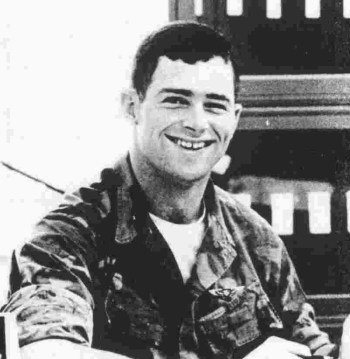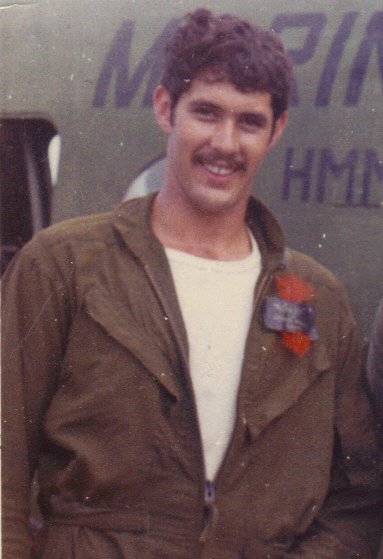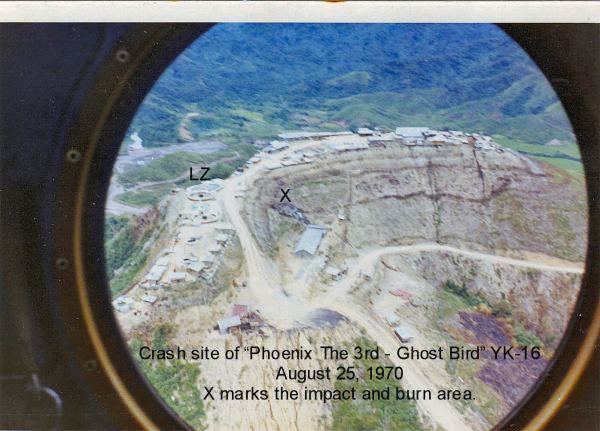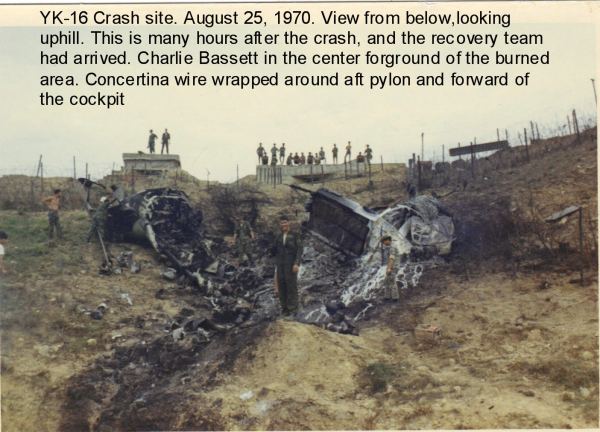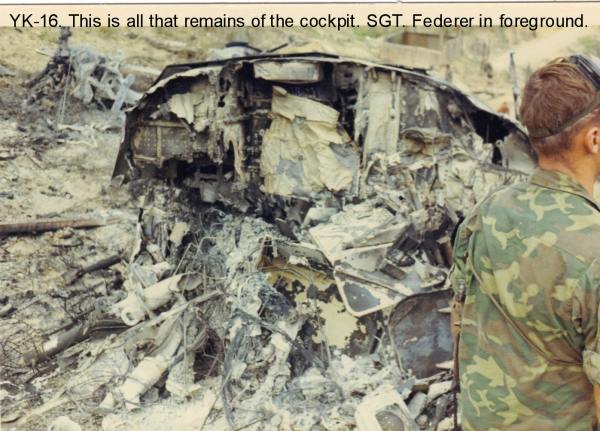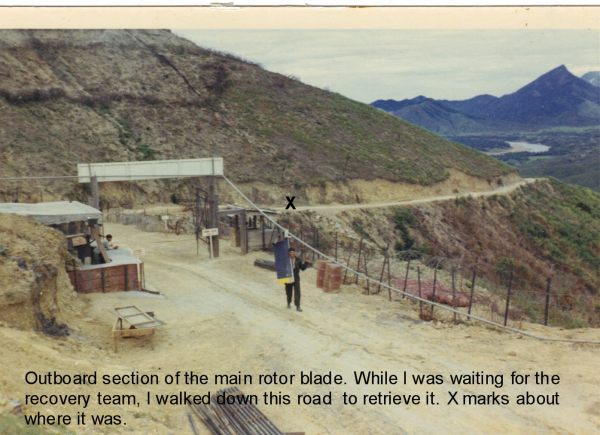|
An entry in the August 1970 Command Chronology stated, "25 Aug. 1970, Aircraft 153995 crashed and burned. There were no fatalities. The crash is under investigation." After locating the After Action Report, with the final entry at AT814384 of "flight terminated", and conferring with as many of the crew as could be found the following depicts what happened. YK-16 with her crew:
No photographs are available for these two Marines They departed Marble Mountain Air Facility at 0620 on Mission 85 and 73 tasked with transporting combat troops and logistical support of various units. By 1140 they had completed seventeen sorties and were preparing to deliver two troops, an internal load of various ammunition including some mortar rounds. They also were delivering food consisting of steak dinners and the always appreciated container of ice cream and a sack of mail. One routine medical evacuee was also along for a ride to the nearest medical facility. The aircraft had ben refueled one sortie prior to this approach to a hilltop out post south of the An Hoa Combat Base. The normal routine in the cockpit was to alternate the tasks of landing and takeoff between the two pilots. On this approach to the hilltop LZ it was Lt. Benson's turn. The approach began and Cpl. Bassett was hanging out his crew door getting ready to pass clearance information on the LZ to Lt. Benson when he noticed they were making their approach downwind. It was possible that the LZ orientation to the terrain and/or other obstructions made this the only way in. Cpl. Bassett noticed they were losing altitude too rapidly, possibly due to power settling, and keyed his intercom saying, "Get it Up! Get it Up." The settling continued even though power was applied and the nose of the aircraft began to pitch up but the rotor RPM was beginning to drop off. It was too late, the aircraft slammed into a 106 recoilless rifle bunker short of the LZ, bounced into the air again with a nose high attitude and began to move backwards. Lt. Chretien took the controls and slammed the collective down in an attempt gain rotor RPM and plant the aircraft solidly on the side of the hill. This would have probably worked in the long run if one, or both, of the fuel tanks had not been ruptured on either the first impact or second landing. The entire aft end of the helicopter exploded. After the initial fireball the rotor blades went out of synchronization, made contact with each other and separated from the aircraft. When all movement ceased Lt. Benson released the emergency door next to his seat and departed the aircraft. SSgt. D. S. Stewart exited through the window of his machine gun location and then proceeded to the rear of the helicopter to assist the passengers who exited through the fire at the rear of the aircraft. The other gunner, Davis, and Cpl. Bassett departed the crew door. Cpl. Bassett began running up the hill toward the LZ only to have his pistol belt slip down over his hips, tangle around his feet and send him sprawling face first into the dirt. Sheepishly he stood up, rearranged his pistol belt and started up the hill again only to find the men in the bunker area yelling at him, waving their arms, and pointing back down the hill toward the burning aircraft. When he turned around he saw Lt. Chretien still in the cockpit. Cpl. Bassett raced back to the burning aircraft, removed the pilot's escape hatch, pulled the release handle to the armor plating of the seat and noticed that Lt. Chretien had released his seat belt and shoulder harness and was ready to jump out. Lt. Cretin had forgotten to unplug the cord to his helmet and that jerked his head back into the cockpit. The helmet was removed, tossed back into the cockpit, and both ran back up the hill through a maze of concertina wire where they each became entangled in the wire. Then the first of the onboard mortars cooked off, they had no additional problems freeing themselves or making it the rest of the way to the top of the hill. Lt. Benson, who had already reached the top of the hill, dove into a hole when the first onboard mortar cooked off and broke his arm. The aircraft burned for a considerable time due to the large amount of jet fuel on board and there were numerous associated explosions from the internal load of ammunition scheduled for the LZ. When the fire diminished and no further explosions, their chase aircraft, YK-15, landed to extract the crew and the passengers who had suffered some serious burns. The burn victims and Lt. Benson were delivered to the NSA Hospital at DaNang and the rest of the crew returned to Marble Mountain with the exception of Cpl. Bassett who remained at the site for the recovery team to arrive. Epilogue 371/2 Years Later Cpl. James L. Bassett
After reaching the top of the hill he recalls the the men fussing at him about the loss of their ice cream. They also lamented the fact that their outpost defenses were not as good as they believed because the crew and passengers had come up the hill through a mine field. Bassett didn't know if he should believe them but, there was only one way to go and that was up the hill. After reaching the top of the hill, Cpl. Bassett and Lt. Chretien were leaning up against a bunker as the aircraft continued to burn and the ordnance continued to explode down the hill. One of seriously burned passengers was brought to them and they were asked to watch and care for him. He had very little clothing left, his skin was black and peeling. Cpl. Bassett was amazed that the man was not in pain and related, "I guess that's what burns do." Cpl. Bassett had just recently been assigned to Bureau No. 153995 which the squadron had just received as a replacement for another YK-16 that was lost on a night medical evacuation mission eighteen days prior on 7 August 1970. Bassett had named his YK-16 "The Phoenix III" referencing the mythical bird that rose from ashes to fly again. Two other CH-46s had borne the same nickname. Cpl. Bassett retrieved the outboard end of one of the rotor blades and painted it with, "Phoenix The Third - Ghost Bird", and the names of the crew, and presented it to the pilots. He believes it was hung in the Pilot's Ready Room. 1stLt. Don Chretien
Great to hear from you directly. I don't recall much about the aftermath of the crash. I guess the adrenaline was running quite high thereafter. I probably felt so bad about the burn victims that I'd blocked that out of my mind. I do recall someone saying we had navigated through a mine field on the way up that hill. But I wasn't sure if that was true or not. I don't know what happened to the blade you brought out but you certainly deserve to have it. Thank you for your efforts that day Charlie, I truly appreciated your taking such a risk to come to my aid. I have two daughters who when reading about this incident ( I had not shared it with them before), cried over what potentially could have happened to me that faithful day. I was also told by my mother, many years ago, that on approximately that same day, she was cleaning in my old room and my picture fell off the wall. It really shook her up and she suspected something had gone terribly wrong. Thanks to you, the worse did not happen and I have lead a very fulfilling life to date. I am now retired living in Maine and enjoying all that life has given me. Thanks again, Semper Fi, "Don" Epilogue 43 Years LaterCpl Michael T. Collins, 1st Recon Bn (passenger)My recollection of 25 Aug 70 was being picked up mid-morning by “Purple Fox” helicopters at the 1st Recon Battalion LZ. There were numerous recon teams from 1st Recon and the ROK marines to be inserted for various missions 73, 85 and resupplying of recon OP. Aboard our helicopter were two recon teams and supplies for the OP. We landed at another LZ to refuel in which we unloaded the two recon teams. After refueling another passenger and I boarded the helicopter with the crew to fly out to the area war cloud Z. Another helicopter departed at the same time with a recon team aboard to be inserted. I don’t know if we were flying with them for support but I do remember watching them being inserted into the field. I was located in the rear of the aircraft on right side. As we started to approach our destination on the hilltop LZ and started our descent we began to hover. I was looking out the window at which time I saw a flash which I thought was ground fire or RPG aiming for rear rotor blade. As I started too reached for my M16 we dropped, hit the ground and began sliding backwards down the hill. I then grabbed on the metal frame of the bench seat to prevent myself from falling into the rear of the aircraft. As we were sliding down the hill like a roller coaster someone up front lost their balance and started falling to the rear of aircraft. I swung around holding onto the bench with my right hand and with my left shoulder blocked and stopped him from falling into the rear of the aircraft onto the supplies. Just at that moment we came to an abrupt stop probably from hitting the concertina wire and I fell into the rear of the aircraft on the mail bags, and mortar round boxes. I remember I was dazed and trying to get up but since the helicopter was probably on a 30-45 degree incline I couldn’t get my footing. Someone reached out to pull me up but just at that moment that’s when the fireball went through the aircraft. There was a wall of fire between me and the other Marine who then exited out the left side door or window. I then realized I couldn’t exit the rear cargo ramp because it was blocked by concertina wire. As my life flashed by in my mind, I could have given up and just sat there to become FUBAR in a few minutes. As Marines we understand from our training not to think about the pain but adapt and overcome the situation. I crawled through the fire up over the supplies and grab the metal bench seat and pulled myself up to the window of the helicopter. I then jumped out the left side window only to find myself entangled in the concertina wire. I do remember someone helping me get out of that mess and then the ammo and mortar rounds started exploding around us. We ran up the hill and jumped into the bunker. I never realized how seriously I was hurt until after a few moments sitting in the bunker I noticed my knee was cut open by the concertina wire. When I reached down to look at my knee I noticed my hands and arms were black and I realized it wasn’t from the dirt. I remember the guys in the bunker telling me I would be ok and a medivac was coming and then they gave me a shot of morphine. I was medivac to the Army 95th Evacuation Hospital. I was there for about 3 days before being transported by helicopter to Da Nang and medical transported to another Army hospital Camp Zama in Japan. I was treated there for 1 month and promoted to Sergeant. I was then transported to Navy Hospital at Great Lakes, IL. I was there for 3 months. I then received orders to report to 4th Marine Air Wing Headquarters, NAS Glenview, IL. I was medically retired on 1 June 1973. I have been married for 37 years, 4 children (3 boys and 1 girl) and 1 grandson.
|

